A feminist take on “Our Man Bashir” and the more dubious elements of the James Bond franchise
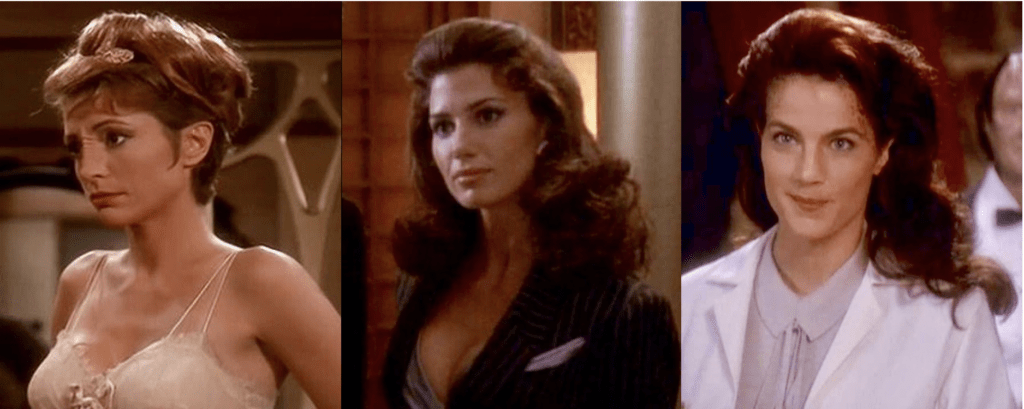
The 24th Century Bond Girls: Colonel Anastasia Komananov, Mona Luvsitt, and Professor Honey Bare
Due to the ongoing pandemic, the release date of the latest iteration of the James Bond movie franchise, No Time to Die, has been pushed back from this November to April 2021. While some people are revisiting the older Bond films, the media coverage for this latest movie prompted me to re-watch the spy thriller Star Trek: Deep Space Nine (DS9) episode, “Our Man Bashir.”
First aired on November 27th, 1995, “Our Man Bashir” features Dr. Julian Bashir’s holo-suite program where he plays a dashing British agent during the Cold War protecting the world from his archnemesis, Falcon. Just before Julian ends his latest adventure with an attractive woman on his arm, Garak enters the holo-suite and amiably critiques Julian’s spy fantasy. Predictably for a holodeck episode, something goes horribly wrong. There is a transporter accident that unwittingly recasts Dax, Kira, Sisko, O’Brien and Worf as characters in Julian’s Bond-style program. Julian and Garak must then bring the holo-narrative to its conclusion to save their friends.
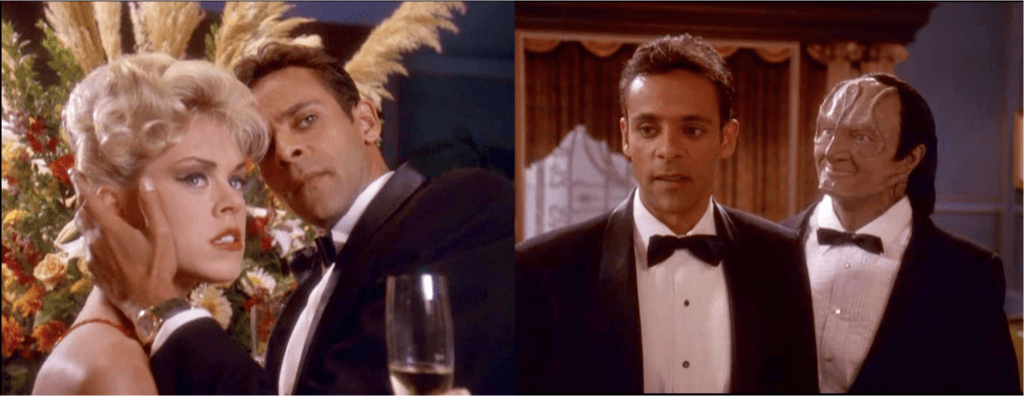
“Isn’t this a rather ostentatious life for a spy?” – Garak. Garak unceremoniously crashes Bashir’s party donning a dashing tuxedo (I don’t know where ‘Garashir’ shippers get their ideas from).
If Bashir playing a secret agent with an over-the-top nemesis wasn’t obvious enough, the episode’s costuming, setting, music and overall tone allude to the James Bond film franchise, which is a mere four years older than Star Trek. Paying particular attention to the women characters, my question diving into this episode was, “Would the James Bond franchise be just as appealing to someone in the 24th century, where there is supposedly gender equality?”
007’s Recipe for Success: Sex and Violence
During my research, I was not shocked to find that women in Bond movies are overly sexualized. What did surprise me was the prevalence of violence against women. In their academic article “Shaken and Stirred: A Content Analysis of Women’s Portrayals in James Bond Films” (2009), Kimberly Neundorf, Thomas Gore, et al. argue that the objectification of women in popular media has real cognitive and behavioral effects. Neundorf and her co-authors analyzed 20 of the James Bond films from 1962-2009 and coded a total of 195 female characters. The study found that 26.7% of all women characters and 88% of the main women characters had some form of sexual contact with Bond. Moreover, 25% of women characters were targeted with a weapon, meaning one-fourth of all the women characters in the franchise pre-2009 had been threatened with violence.
The data shows a clear correlation between sexualizing and violating women’s bodies in these films. The authors conclude this linkage between sex and violence is what makes James Bond so appealing to audiences and concerning to social scientists. During the 1990’s when “Our Man Bashir” aired, the study shows a significant increase in the number of women’s roles in Bond films. However, there was also a corresponding increase in portraying women characters as being sexually active and as being physically harmed.
Bashir Girls
Sex and violence are also a central component to Bashir’s secret agent fantasy, as demonstrated by the unfortunate character of Mona Luvsitt. Just before the transporter emergency disrupts the program, Bashir introduces Garak to his personal valet. Julian boasts:
Mona is very capable. She speaks seven languages, has degrees in biology, chemistry, physics, can fly anything from a jet to a helicopter and makes an excellent martini. Cheers.
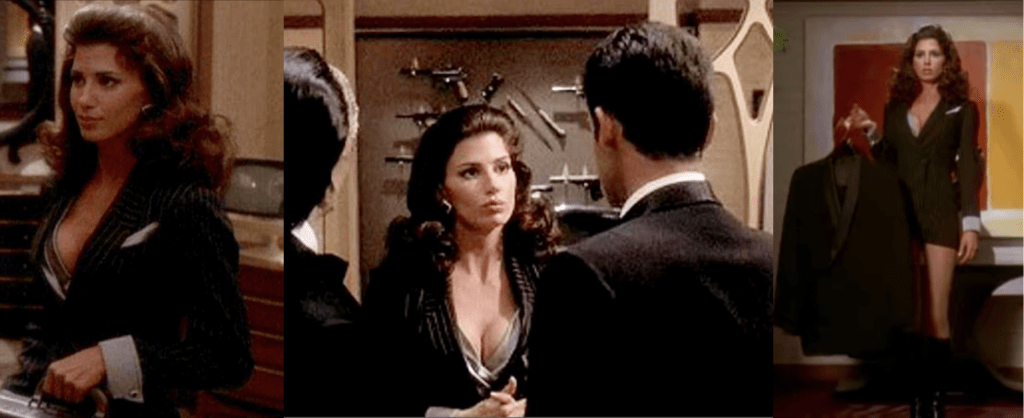
Played by Marci Brickhouse, Mona Luvsitt’s professionally competent character is murdered in the beginning of Julian’s 20th century holo-program. Like in a 007 movie, the women characters in Bashir’s program are used as plot devices to serve up a sex and violence cocktail.
However, Mona never gets to demonstrate her skills as she is almost immediately killed by Bashir’s nemesis Falcon, played by O’Brien. Mona Luvsitt’s purpose is to present the Bond films’ formula for success, a combination of sex and violence, by overtly sexualizing her with a suggestive name and revealing costume and then plunging a knife into her back. Mona’s violent demise only serves to add to the dramatic tension of Julian realizing his friend Miles has been cast in the role of a killer.
In Bashir’s program, Mona Luvsitt is but one example of what has become known as the Bond Girl archetype. The ‘Bond Girl’ is a protagonist or an antagonist who ultimately assists and has a romantic liaison with Bond, reducing women to disposable plot devices. Neundorf et al. explain:
“Bond girls,” a now pejorative term in itself, often play independent, highly intelligent roles as heroes, villains, other agents, or professionals. However, as autonomous as these characters are initially depicted, they are often identified as an adjunct to Bond (the male protagonist), or in terms of their relationship to other male characters. Correspondingly, many female characters in the 007 films are framed as objects of sex or violence, or considered easily dispensable. (Neundorf et al. pg 761)
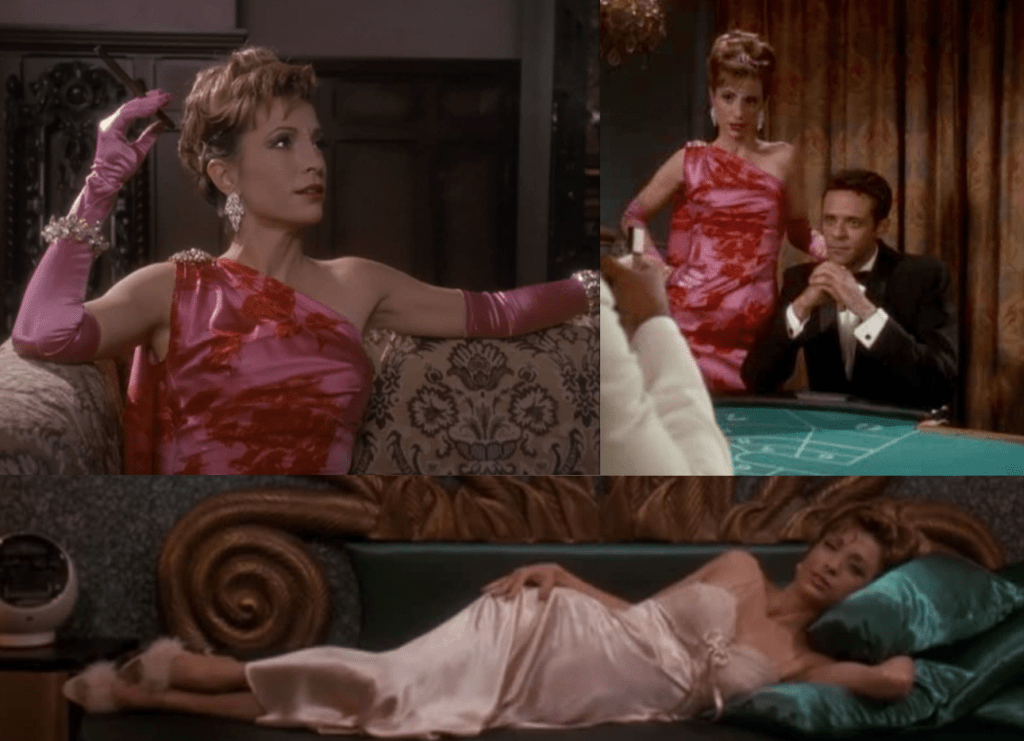
“I must say Major Kira is certainly throwing herself into the role, Doctor” – Garak. Insinuating a previous romantic relationship, Kira’s character, Komananov, is content to let Bashir lead a secret mission of global importance she herself was initially assigned.
Within Julian’s spy fantasy, Major Kira’s character embodies the classic Bond Girl whose job is to assist Bashir in his mission and look sexy while doing it. Major Kira assumes the role of KGB agent Colonel Anastasia Komananov, who enlists Bashir on behalf of her government to stop Dr. Hippocrates Noah, aka Sisko, from destroying the world. We first see Komananov lying seductively across Julian’s bed in pink satin chemise lingerie. Komananov is presumably a capable secret agent in her own right, though we don’t get to see her do much besides follow Bashir around in pretty clothes and, at the end, be held hostage by Dr. Noah, who wants her to help repopulate his new world (gross!).
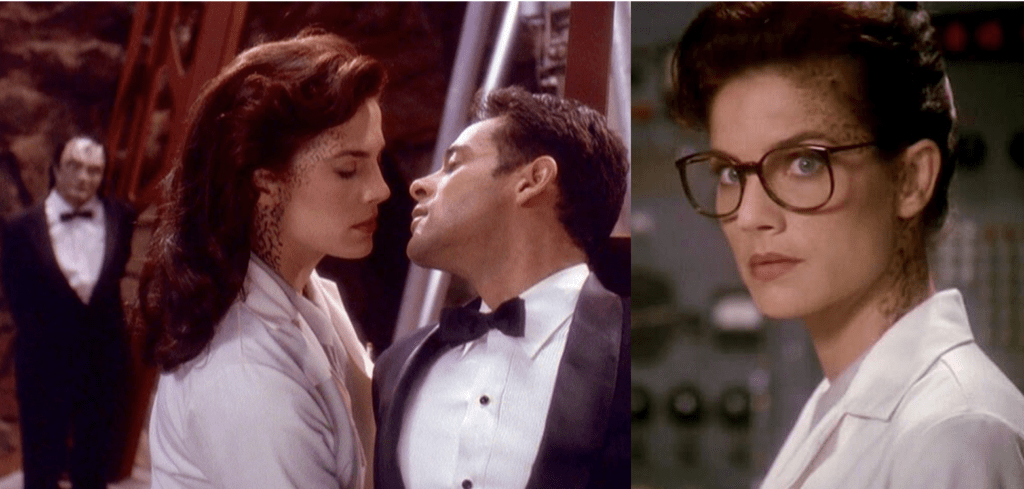
“What a waste that no one can see what a beautiful woman you are.” – Agent Bashir. Dax’s holo-suite character, Professor Honey Bare, is clearly meant to be an attractive female antagonist who ultimately helps Bashir’s character.
The only other woman involved in the transporter accident, Lt. Commander Dax, plays Professor Honey Bare, a reportedly brilliant seismologist helping Dr. Noah’s evil scheme to flood the Earth with a network of lasers. She is first presented as a kidnapping victim, but it’s later revealed she works for Noah. Honey Bare wears a large white lab coat and thick rimmed glasses with her hair pinned up- a transparent (failed) attempt to make her appear cerebral and therefore less attractive. In one particularly cringy scene, Bashir flatters Honey Bare into helping him escape being killed by one of Dr. Noah’s lasers, encouraging her to take off her glasses and let her hair down so he can see how beautiful she is. Honey Bare releasing Bashir reinforces the trope of Bond girls as a plot device to emphasize the heterosexuality and superior capabilities of the Bond character. Fortunately, Garak does expose the ridiculousness of the situation, commenting:
Kiss the girl, get the key. They never taught me that in the Obsidian Order.
Having avoided death by molten lava, Julian explains to Garak that they must go back to save his friends still trapped in their holo-novel personas, particularly Kira and Dax:
If this program ends like the others, either Komananov or Honey Bare will be killed by Doctor Noah, the other is supposed to end up with me.
This singular line problematizes the treatment of women characters in these spy narratives and alludes to the fact our women protagonists on DS9 have been changed into, some could say reduced to, the Bond girl cliché: the attractive, competent woman who either ends up dead or in a romantic relationship with Bond.
Who are 24th Century Bond Girls?
Focusing on the portrayal of women in this episode, “Our Man Bashir” does draw attention to the violence against women which is a main component of the 007 film franchise. In the episode, Bashir seems at least aware of the sexist tropes in the spy action genre however, he nor the person who created the program seem to have a problem with reproducing them. Furthermore, the holo-novel is experienced in the first person. In the 24th century you don’t just get to live these violent fantasies though Bond; you can also become him.
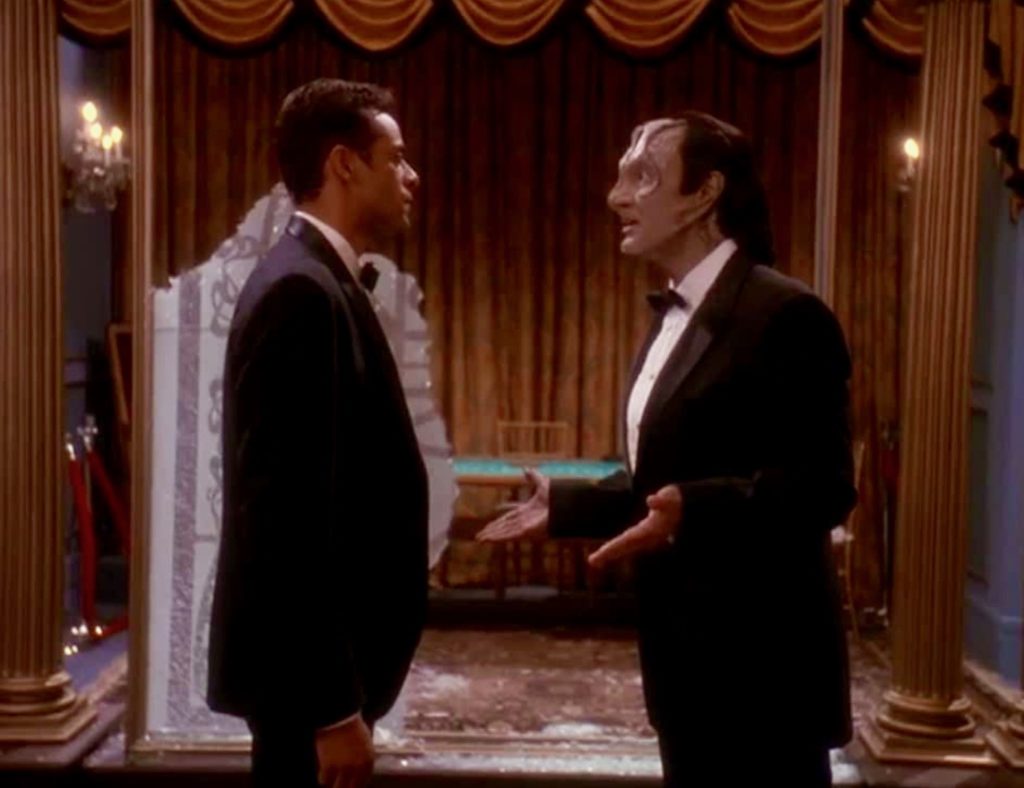
“This is more than I ever wanted to know about your fantasy life.” – Garak
In the 24th century, I would hope a franchise based on objectifying and killing women would be approached with a more critical eye. Of course, viewers today can still enjoy the Bond films and “Our Man Bashir,” although hopefully with a degree of critical thinking about the Bond franchise and understanding of its potential real-world effects. It is important to consider why certain media remains popular, what audience it serves and what message it sends now and for future generations.
Moreover, it would be interesting to imagine how the Bond franchise might transform into the future along with changing social norms. When Bashir’s secret agent holo-suite program is revisited in later episodes of DS9, it would have been fascinating to see Dax’s take on the charismatic spy character. If women were to reclaim the franchise or at least improve their representation in it, then I think Bond would have the potential to continue entertaining into the 24th Century.